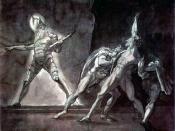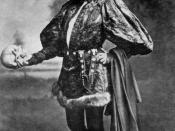The character of Hamlet is often referred to as the ÃÂRenaissance manà(Lacey Baldwin Smith, 1967) and the Romantic French author, Alexandre Dumas Père, claimed that ÃÂafter God, Shakespeare has created the mostÃÂ. Over the past 400 years the play itself has been subjected to feverish analysis by scholars, psychologists, and critics àHamlet is timeless. Indeed, as the First Folio published in 1623 states, William ShakespeareÃÂs plays are meant to be ÃÂreadeàagaine and againeÃÂ.
It is believed that Hamlet was first enacted in July 1602 at the Globe Theatre in London, and although its productions have changed dramatically over the centuries ÃÂ with the introduction of artificial lighting, modern music and stage effects ÃÂ it remains one of the most frequently performed plays of all time. One of the main reasons behind the revenge tragedyÃÂs success is the playwrightÃÂs ability to construct complex and intricately detailed characters, which seem to not only have a voice and personality, but a deeper conscience, too.
No two performances ever portray Prince Hamlet of Denmark in the same light, for the play is riddled with ambiguities. It is, therefore, up to directors and actors to decide how to answer one of the most controversial questions: was HamletÃÂs madness ever real, or was it all merely an act?To answer whether or not Hamlet is such, the possible causes of his madness must first be examined. From the princeÃÂs first appearance in Act I Scene 2, it is clear that he is very much disturbed. It seems that the main reason is due to ÃÂHis fatherÃÂs death, and [GertrudeÃÂs and ClaudiusÃÂs] oÃÂerhasty marriageÃÂ (II.ii.57). Indeed, ÃÂThe funeral baked meats / Did coldly furnish forth the marriage tablesÃÂ (I.ii.180-181). The Elizabethan audience at the time could relate this to Mary Queen of Scots, who not...


